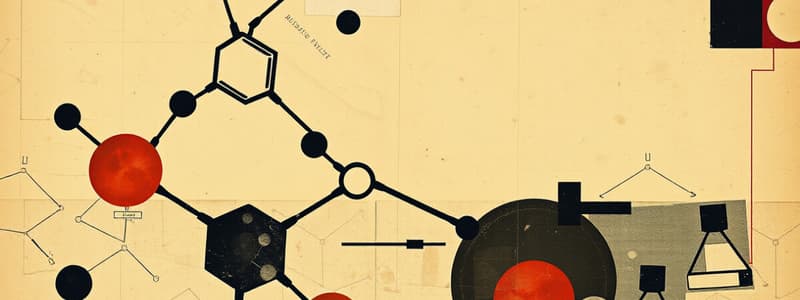Podcast
Questions and Answers
What is the result of adding HBr to an alkene?
What is the result of adding HBr to an alkene?
- Anti addition of H and Br
- No reaction
- Syn addition of H+ and Br-
- Markovnikov addition of H+ and Br- (correct)
Bromination of alkenes with Br2 results in syn addition.
Bromination of alkenes with Br2 results in syn addition.
False (B)
What type of reaction occurs during oxidative cleavage under reducing conditions?
What type of reaction occurs during oxidative cleavage under reducing conditions?
Ozonolysis
In the presence of acidic conditions, H3O+ adds _____ and _____ to alkenes.
In the presence of acidic conditions, H3O+ adds _____ and _____ to alkenes.
Match the following reagents with their product types:
Match the following reagents with their product types:
Which reagent pair would give an anti-Markovnikov addition to an alkene?
Which reagent pair would give an anti-Markovnikov addition to an alkene?
All reactions that form chiral centers from alkenes produce only one product.
All reactions that form chiral centers from alkenes produce only one product.
Identify the intermediate formed when alkenes react with Br2.
Identify the intermediate formed when alkenes react with Br2.
Ozonolysis under reducing conditions involves the reaction of O3 with alkenes at _____°C.
Ozonolysis under reducing conditions involves the reaction of O3 with alkenes at _____°C.
What is the stereo selectivity of the reaction involving H2 and a catalyst with alkenes?
What is the stereo selectivity of the reaction involving H2 and a catalyst with alkenes?
Which reagent pair results in an anti addition to alkenes?
Which reagent pair results in an anti addition to alkenes?
The addition of H2 in the presence of a catalyst results in anti stereochemistry.
The addition of H2 in the presence of a catalyst results in anti stereochemistry.
What is the regioselectivity of HBr addition to alkenes?
What is the regioselectivity of HBr addition to alkenes?
The reaction involving (1) BH3 THF (2) H2O2, OH, H2O results in _____ addition and is called _____ addition.
The reaction involving (1) BH3 THF (2) H2O2, OH, H2O results in _____ addition and is called _____ addition.
Match the following types of reagent conditions with their associated type of cleavage:
Match the following types of reagent conditions with their associated type of cleavage:
Which intermediate is formed during the reaction with Br2 and H2O?
Which intermediate is formed during the reaction with Br2 and H2O?
List the usual number of products formed when 1 chiral center is present after an alkene reaction.
List the usual number of products formed when 1 chiral center is present after an alkene reaction.
All reactions that form chiral centers produce a maximum of four products.
All reactions that form chiral centers produce a maximum of four products.
The process of ozonolysis under _____ conditions involves O3 and yields carbonyl compounds.
The process of ozonolysis under _____ conditions involves O3 and yields carbonyl compounds.
Match the following reagents with their regioselectivity:
Match the following reagents with their regioselectivity:
Match the following reagents with their stereo selectivity:
Match the following reagents with their stereo selectivity:
Match the following intermediate types with their corresponding reagents:
Match the following intermediate types with their corresponding reagents:
Match the following reagents with the products they yield:
Match the following reagents with the products they yield:
Match the following reagents with their specific rearrangement possibility:
Match the following reagents with their specific rearrangement possibility:
Match the following types of products with the usual number formed:
Match the following types of products with the usual number formed:
Match the following reagents with what’s added:
Match the following reagents with what’s added:
Match the following conditions under which ozonolysis occurs:
Match the following conditions under which ozonolysis occurs:
Match the following reagents with the type of addition they perform:
Match the following reagents with the type of addition they perform:
Flashcards are hidden until you start studying
Study Notes
Electrophilic Addition Reactions to Alkenes
- Electrophilic addition involves adding reagents across the double bond of alkenes.
- Different reagents influence the products' regioselectivity and stereochemistry.
Reagents and Their Additions
- HBr, HCl, HI: Adds H+ and Br; follows Markovnikov's rule; produces a carbocation intermediate, possible rearrangements.
- H3O+: Adds H+ and OH; follows Markovnikov's rule; also produces a carbocation, allows rearrangements.
- H+, ROH: Introduces H+ and OR; follows Markovnikov's rule with potential carbocation rearrangements.
- Br2/CCl4 or Cl2: Adds Br+ and Br; no regioselectivity; anti stereochemistry with bromonium ion formation; no rearrangements.
- Br2/H2O: Introduces Br+ and OH; Markovnikov's rule applies; anti stereochemistry from bromonium ion; no rearrangements.
- Cl2/H2O: Adds Cl+ and OH; Markovnikov’s rule; follows anti stereochemistry with bromonium ion; no rearrangements.
Further Reagents and Their Effects
- Br2/ROH and Cl2/ROH: Both follow Markovnikov’s rule, forming OR; anti stereochemistry with mercurinium ion; no rearrangements.
- (1) Hg(OAc)2, H2O (2) NaBH4: Creates H+ and OR based on Markovnikov's rule; anti stereochemistry; no rearrangements noted.
- (1) Hg(OAc)2, ROH (2) NaBH4: Delivers H+ and OH following anti-Markovnikov's rule; syn stereochemistry; no rearrangements.
- (1) BH3 THF (2) H2O2, OH, H2O: Results in the addition of H and H without regioselectivity and syn stereochemistry; no rearrangements.
Notable Conditions and Results
- H2/catalyst (Pd/C, Pt/C, or Ni): Adds H and Br against anti-Markovnikov’s rule; produces a radical; no rearrangements.
- HBr/ROOR (peroxide): Adds an O without regioselectivity; syn stereochemistry; no rearrangements.
- RCO3H (MCPBA): Produces two OH groups with anti stereochemistry; no rearrangements.
- (1) RCO3H (2) H3O+: Yields two OH groups in a syn manner; no rearrangements.
- (1) OsO4 (2) H2O2: Adds two OH groups with syn stereochemistry; no rearrangements.
- KMnO4 (cold, dilute)/OH-: Reaction proceeds under specific conditions leading to OH group addition.
Chiral Centers and Products
- No chiral centers yield one product.
- One chiral center produces two distinct products.
- Two chiral centers can generate four products with configurations based on syn or anti addition, resulting in a diverse product profile.
Oxidative Cleavage of Alkenes
Reducing Conditions
- (1) O3, -78°C (2) (CH3)2S or Zn/H2O: Cleaves alkenes under reducing conditions.
Oxidizing Conditions
- (1) O3 (2) H2O2: Utilizes ozone followed by hydrogen peroxide for oxidative cleavage.
- KMnO4 (hot, concentrated)/OH or H3O+: Another method for oxidative cleavage of alkenes under concentrated oxidative conditions.
Electrophilic Addition Reactions to Alkenes
- Electrophilic addition involves the reaction of alkenes with various reagents, leading to different products based on the nature of the reagents and conditions.
- HBr, HCl, HI: Adds H+ and halogen (Br, Cl, I) following Markovnikov's rule, forming a carbocation intermediate; rearrangements may occur.
- H3O+: Adds H+ and OH (hydroxyl) group, also following Markovnikov's rule with possible carbocation rearrangements.
- H+, ROH: Produces H+ and an alkoxy group (OR) via Markovnikov addition; carbocation intermediates are possible.
- Br2/CCl4 or Cl2: Adds two bromine atoms in an anti manner; forms a bromonium ion intermediate, no rearrangement occurs.
- Br2/H2O: Adds Br+ and OH group with Markovnikov selectivity in an anti manner, utilizing a bromonium ion.
- Cl2/H2O: Similar to Br2/H2O, but with chlorine; adds Cl+ and OH in an anti fashion using a bromonium ion.
- Br2/ROH or Cl2/ROH: Markovnikov addition of Br+ or Cl+ and OR, operating with anti stereochemistry via a mercurinium ion.
- Mercury Acetate (Hg(OAc)2): Hydrolysis (H2O) or alcohol (ROH) gives Markovnikov addition with anti selectivity without rearrangement.
- BH3/THF followed by hydrogen peroxide: This results in anti-Markovnikov addition of OH, with syn stereochemistry.
- Hydrogenation (H2 with catalyst): Adds H and H in syn fashion; can use Pd/C, Pt/C, or Ni as catalysts.
- HBr/ROOR (peroxide): Leads to anti-Markovnikov addition of H and Br due to radical formation.
- RCO3H (MCPBA): Produces an epoxide (O) in syn manner from alkenes.
- Two-step reactions with MCPBA followed by H3O+: This results in anti addition of two OH groups.
- OsO4 and hydrogen peroxide: Also results in syn addition of two OH groups.
- KMnO4 (cold, dilute/OH-): Gives syn addition producing two hydroxyl groups.
Oxidative Cleavage of Alkenes
- Reducing conditions: Ozone (O3) at -78°C, followed by (CH3)2S or Zn/H2O cleaves alkenes.
- Oxidizing conditions: Ozone followed by hydrogen peroxide or KMnO4 under hot and concentrated conditions cleaves alkenes.
Chiral Centers and Products
- Formation of chiral centers affects product distribution:
- 0 chiral centers: Produces 1 product.
- 1 chiral center: Creates 2 distinct products.
- 2 chiral centers: Generates 2 syn, 2 anti, and 4 without any defined configuration, totaling 8 potential products from this scenario.
Electrophilic Addition Reactions to Alkenes
- Electrophilic addition involves the reaction of alkenes with various reagents to form different products.
- Reagents and Products: Common reagents include HBr, H3O+, and Br2, leading to the addition of H, OH, or Br.
- Regioselectivity: Most reactions follow Markovnikov's rule, favoring the more stable carbocation during addition.
- Stereo selectivity: Anti addition occurs with haloalkanes (Br2, Cl2) while syn addition is seen with hydrogenation and certain oxidants (like Osmium tetroxide).
- Intermediate species: Typical intermediates include carbocations, bromonium ions, and mercurinium ions, affecting the final product morphology.
- Rearrangements: Carbocation intermediates may rearrange for stability, while others do not undergo rearrangement.
Key Reagents and Their Characteristics
- HBr, HCl, HI: Add H+ and X-; possible rearrangements occur.
- H3O+: Similar to hydrogen halides with regioselective focus on Markovnikov addition.
- Br2/CCl4: Results in anti addition forming a bromonium ion; no rearrangements occur.
- Br2/H2O and Cl2/H2O: Add OH and X- (Markovnikov) with anti stereochemistry.
- Hydroboration-Oxidation (BH3 then H2O2): Achieves anti-Markovnikov addition leading to syn addition of OH.
- Catalytic Hydrogenation: Produces syn addition of hydrogen with catalysts like Pd/C, Pt/C, or Ni.
- Radical addition with HBr/ROOR: Follows anti-Markovnikov rules through a radical mechanism.
Chiral Centers Formed
- Reactions can produce chiral centers, resulting in either 1 or 2 products, depending on the initial substrate layout.
- The formation of 2 products is typical with one chiral center while 2 chiral centers lead to combinations of syn and anti isomers.
Oxidative Cleavage of Alkenes
- Ozonolysis (O3, -78°): Used under reducing conditions for oxidative cleavage of alkenes, leading to the formation of carbonyl compounds.
Studying That Suits You
Use AI to generate personalized quizzes and flashcards to suit your learning preferences.




